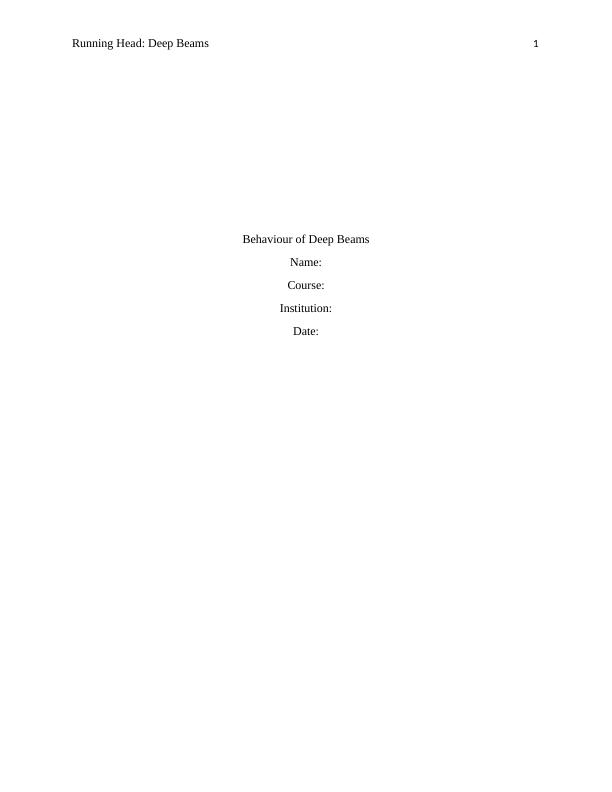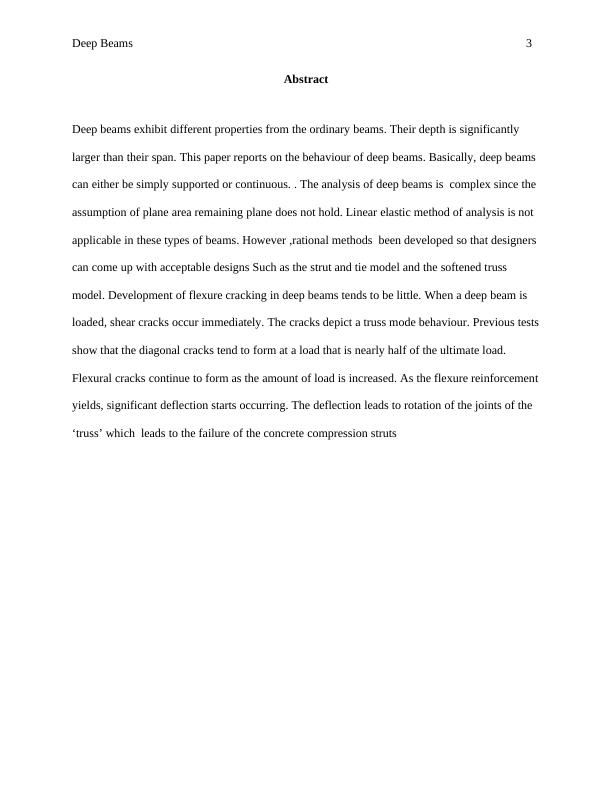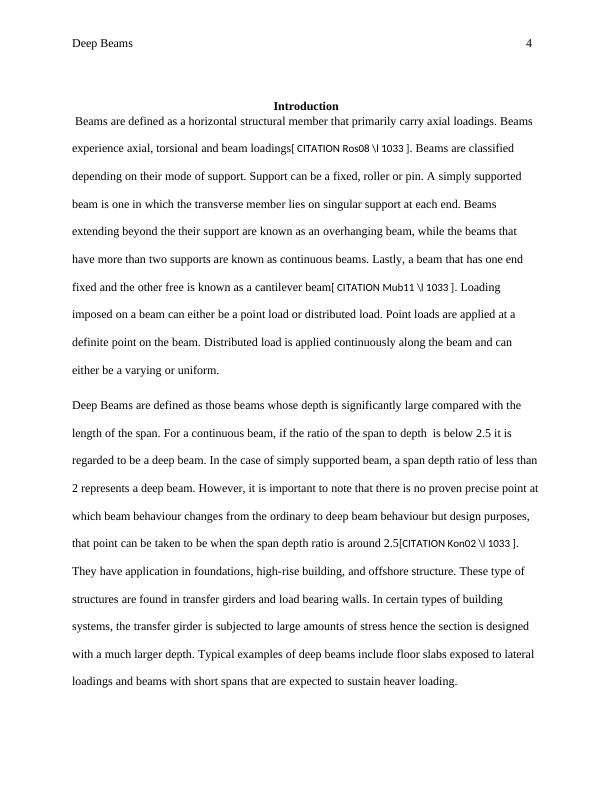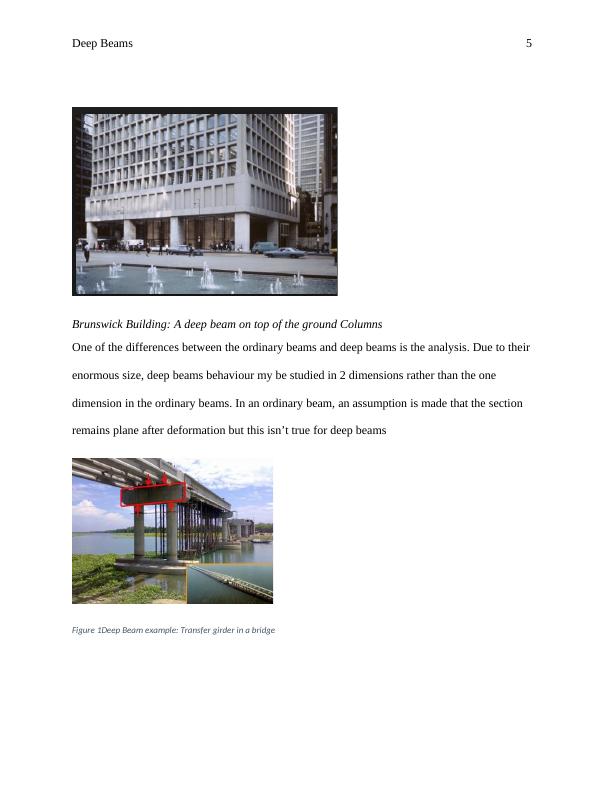Ask a question from expert
Paper Report on Behaviour of Deep Beams
21 Pages3330 Words260 Views
Added on 2020-05-11
Paper Report on Behaviour of Deep Beams
Added on 2020-05-11
BookmarkShareRelated Documents
Running Head: Deep Beams 1Behaviour of Deep BeamsName:Course:Institution:Date:

Deep Beams 2Table of ContentsAbstract............................................................................................................................................3Introduction......................................................................................................................................4Properties, Strength and Behaviour.................................................................................................8Strut and Tie.................................................................................................................................8Continuous Deep Beams............................................................................................................10Deep Beams with Web openings...............................................................................................12Modes of failure.............................................................................................................................16Flexural Failure..........................................................................................................................16Shear Failure..............................................................................................................................16Combined Shear and Flexural Failure.......................................................................................17Local Failure..............................................................................................................................18Compression Failure..................................................................................................................19References......................................................................................................................................20

Deep Beams 3AbstractDeep beams exhibit different properties from the ordinary beams. Their depth is significantly larger than their span. This paper reports on the behaviour of deep beams. Basically, deep beams can either be simply supported or continuous. . The analysis of deep beams is complex since the assumption of plane area remaining plane does not hold. Linear elastic method of analysis is not applicable in these types of beams. However ,rational methods been developed so that designers can come up with acceptable designs Such as the strut and tie model and the softened truss model. Development of flexure cracking in deep beams tends to be little. When a deep beam is loaded, shear cracks occur immediately. The cracks depict a truss mode behaviour. Previous testsshow that the diagonal cracks tend to form at a load that is nearly half of the ultimate load. Flexural cracks continue to form as the amount of load is increased. As the flexure reinforcementyields, significant deflection starts occurring. The deflection leads to rotation of the joints of the ‘truss’ which leads to the failure of the concrete compression struts

Deep Beams 4Introduction Beams are defined as a horizontal structural member that primarily carry axial loadings. Beams experience axial, torsional and beam loadings[ CITATION Ros08 \l 1033 ]. Beams are classified depending on their mode of support. Support can be a fixed, roller or pin. A simply supported beam is one in which the transverse member lies on singular support at each end. Beams extending beyond the their support are known as an overhanging beam, while the beams that have more than two supports are known as continuous beams. Lastly, a beam that has one end fixed and the other free is known as a cantilever beam[ CITATION Mub11 \l 1033 ]. Loading imposed on a beam can either be a point load or distributed load. Point loads are applied at a definite point on the beam. Distributed load is applied continuously along the beam and can either be a varying or uniform. Deep Beams are defined as those beams whose depth is significantly large compared with the length of the span. For a continuous beam, if the ratio of the span to depth is below 2.5 it is regarded to be a deep beam. In the case of simply supported beam, a span depth ratio of less than2 represents a deep beam. However, it is important to note that there is no proven precise point atwhich beam behaviour changes from the ordinary to deep beam behaviour but design purposes, that point can be taken to be when the span depth ratio is around 2.5[CITATION Kon02 \l 1033 ].They have application in foundations, high-rise building, and offshore structure. These type of structures are found in transfer girders and load bearing walls. In certain types of building systems, the transfer girder is subjected to large amounts of stress hence the section is designed with a much larger depth. Typical examples of deep beams include floor slabs exposed to lateral loadings and beams with short spans that are expected to sustain heaver loading.

Deep Beams 5Brunswick Building: A deep beam on top of the ground ColumnsOne of the differences between the ordinary beams and deep beams is the analysis. Due to their enormous size, deep beams behaviour my be studied in 2 dimensions rather than the one dimension in the ordinary beams. In an ordinary beam, an assumption is made that the section remains plane after deformation but this isn’t true for deep beamsFigure 1Deep Beam example: Transfer girder in a bridge

Deep Beams 6Bridge with deep beam(Jakway Part Bridge, Buchanan County, Iowa

End of preview
Want to access all the pages? Upload your documents or become a member.
Related Documents
Analysis of Deep Beams Report Assignmentlg...
|12
|2965
|153
Understanding Beams: Behavior, Failure Modes, Stresses, and Types Used in Constructionlg...
|13
|2852
|300
Static Engineering System Assignmentlg...
|32
|3416
|392
Torsional Buckling of Beams Reportlg...
|16
|3450
|209